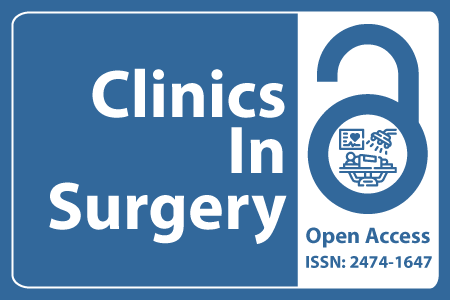
Journal Basic Info
- Impact Factor: 1.995**
- H-Index: 8
- ISSN: 2474-1647
- DOI: 10.25107/2474-1647
Major Scope
- Cardiovascular Surgery
- Neurological Surgery
- Plastic Surgery
- Otolaryngology - Head and Neck Surgery
- Bariatric Surgery
- Minimally Invasive Surgery
- Gastroenterological Surgery
- Endocrine Surgery
Abstract
Citation: Clin Surg. 2019;4(1):2374.Research Article | Open Access
Use of a Statewide Trauma Image Repository Decreases the Rate of Unnecessary Transfers to a Level 1 Trauma Center
Harris TJ, Fair LC, Jensen HK, Karim S, Imus TL, Beck WC, Bhavaraju A, Davis B, Kimbrough MK, Robertson RD, Taylor JR and Sexton KW
Department of Surgery, Division of Trauma and Acute Care Surgery, University of Arkansas for Medical Sciences (UAMS), USA
*Correspondance to: Kevin W Sexton
PDF Full Text DOI: 10.25107/2474-1647.2374
Abstract
Background: We hypothesized that implementation of a statewide Trauma Image Repository (TIR) would lead to increased efficiency of care.
Methods: The state of Arkansas instituted TIR in July 2013. In this retrospective cohort study, we analyzed patients in the Arkansas trauma registry from December 2013 through May 2017, and compared patients with images loaded to the TIR with those without images in TIR.
Results: Altogether 2,354 patients were included in the study, and the utilization of the TIR increased from 44% to 74% of all transfers during the study period. The patients in the TIR group were more likely to be admitted to the ICU from the ED (25.84% vs. 18.09%, p<0.01). TIR patients had longer LOS (5.3 + 6.7 vs. 4.6 + 6.2 days, p<0.01) and a longer ICU LOS (1.8 + 4.1 vs.1.3 + 3.4 days, p<0.01). Patients in the TIR group also had a higher mean ISS (11.7 + 9.8 vs. 9.1 + 8.8, p<0.01. There was no difference in mortality between the two groups.
Conclusion: The implementation of a state-wide TIR led to a lower proportion of patients being transferred with an injury severity score less than 15. Patients with images in the TIR had more severe injuries and a higher predicted mortality. While they were shown to have longer hospital and ICU length of stay, there was no difference in mortality between the two groups. We can speculate that the increased efficiency potentially led to more seriously injured people surviving at the same rate as the less severely injured patients.
Keywords
Trauma; Imaging; Transfer Image Repository; Tertiary center
Cite the article
Harris TJ, Fair LC, Jensen HK, Karim S, Imus TL, Beck WC, et al. Use of a Statewide Trauma Image Repository Decreases the Rate of Unnecessary Transfers to a Level 1 Trauma Center. Clin Surg. 2019; 4: 2374.













